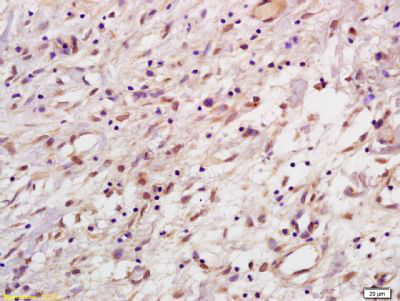产品货号 : mlR2969
英文名称 : HPV33 E7
中文名称 : 人类乳头状瘤病毒33抗体
别 名 : E7 protein [Human papillomavirus type 33]; Human Papilloma Virus; Human papillomavirus type 33; Human papillomavirus type 33; Protein 33; early protein E7 [Human papillomavirus type 33].
研究领域 : 肿瘤 免疫学 细菌及病毒
抗体来源 : Rabbit
克隆类型 : Polyclonal
交叉反应 : Human, HPV33/HPV58
产品应用 : ELISA=1:500-1000 IHC-P=1:400-800 IHC-F=1:400-800 IF=1:100-500 (石蜡切片需做抗原修复)
not yet tested in other applications.
optimal dilutions/concentrations should be determined by the end user.
分 子 量 : 11kDa
性 状 : Lyophilized or Liquid
浓 度 : 1mg/ml
免 疫 原 : KLH conjugated synthetic peptide derived from HPV33 E7:41-97/97
亚 型 : IgG
纯化方法 : affinity purified by Protein A
储 存 液 : 0.01M TBS(pH7.4) with 1% BSA, 0.03% Proclin300 and 50% Glycerol.
保存条件 : Store at -20 °C for one year. Avoid repeated freeze/thaw cycles. The lyophilized antibody is stable at room temperature for at least one month and for greater than a year when kept at -20°C. When reconstituted in sterile pH 7.4 0.01M PBS or diluent of antibody the antibody is stable for at least two weeks at 2-4 °C.
PubMed : PubMed
产品介绍 : Human papilloma viruses (HPVs) can be classified as either high risk or low risk according to their association with cancer. HPV16 and HPV18 are the most common of the high risk group while HPV6 and HPV11 are among the low risk types. Approximately 90% of cervical cancers contain HPV DNA of the high risk types. Mutational analysis have shown that the E6 and E7 genes of the high risk HPVs are necessary and sufficient for HPV transforming function. The specific interactions of the E6 and E7 proteins with p53 and pRB, respectively, correlate with HPV high and low risk classifications. The high risk HPV E7 proteins bind to pRB with a higher affinity than do the low risk HPV proteins, and only the high risk HPV E6 proteins form detectable complexes with p53 in vitro.
Human papillomaviruses (HPV) are small DNA viruses which infect epithelia of the skin and mucosa. Over 90 types have been identified and they mostly cause a variety of benign lesions such as warts and verrucae. However, some subtypes, notably types 16 and 18, 31 and 33, have been confirmed as agents which cause cervical cancer.
Function:
E7 protein has both transforming and trans-activating activities. Disrupts the function of host retinoblastoma protein RB1/pRb, which is a key regulator of the cell cycle. Induces the disassembly of the E2F1 transcription factors from RB1, with subsequent transcriptional activation of E2F1-regulated S-phase genes. Inactivation of the ability of RB1 to arrest the cell cycle is critical for cellular transformation, uncontrolled cellular growth and proliferation induced by viral infection. Stimulation of progression from G1 to S phase allows the virus to efficiently use the cellular DNA replicating machinery to achieve viral genome replication. Interferes with histone deacetylation mediated by HDAC1 and HDAC2, leading to activation of transcription.
Subunit:
Homodimer. Homooligomer. Interaction with host RB1 induces the aberrant dissociation of RB1-E2F1 complex thereby disrupting RB1's activity. Binds to CHD3 through its zinc-finger domain. Forms a complex with CHD3 and HDAC1, thereby altering the action of host histone deacetylation. A similar complex involving E7, CHD3 and HDAC2 might also form.
Similarity:
Belongs to the papillomaviridae E7 protein family.
SWISS:
P06429
Gene ID:
N/A
Important Note:
This product as supplied is intended for research use only, not for use in human, therapeutic or diagnostic applications.
人类乳头状瘤病毒33(HPV33)是导致女性宫颈癌的主要病毒型(包括人类乳头状瘤病毒33)属于高危亚型人类乳头状瘤病毒。
产品图片 :












